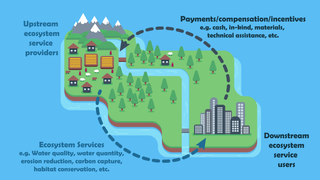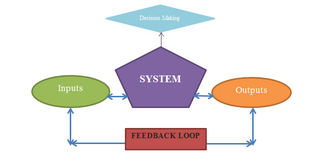
Natural capital is the world's stock of natural resources, which includes geology, soils, air, water and all living organisms. Some natural capital assets provide people with free goods and services, often called ecosystem services. All of these underpin our economy and society, and thus make human life possible.

Environmental economics is a sub-field of economics concerned with environmental issues. It has become a widely studied subject due to growing environmental concerns in the twenty-first century. Environmental economics "undertakes theoretical or empirical studies of the economic effects of national or local environmental policies around the world. ... Particular issues include the costs and benefits of alternative environmental policies to deal with air pollution, water quality, toxic substances, solid waste, and global warming."

Ecotourism is a form of tourism involving responsible travel to natural areas, conserving the environment, and improving the well-being of the local people. Its purpose may be to educate the traveler, to provide funds for ecological conservation, to directly benefit the economic development and political empowerment of local communities, or to foster respect for different cultures and for human rights. Since the 1980s, ecotourism has been considered a critical endeavor by environmentalists, so that future generations may experience destinations relatively untouched by human intervention. Ecotourism may focus on educating travelers on local environments and natural surroundings with an eye to ecological conservation. Some include in the definition of ecotourism the effort to produce economic opportunities that make conservation of natural resources financially possible.

Ecological economics, bioeconomics, ecolonomy, eco-economics, or ecol-econ is both a transdisciplinary and an interdisciplinary field of academic research addressing the interdependence and coevolution of human economies and natural ecosystems, both intertemporally and spatially. By treating the economy as a subsystem of Earth's larger ecosystem, and by emphasizing the preservation of natural capital, the field of ecological economics is differentiated from environmental economics, which is the mainstream economic analysis of the environment. One survey of German economists found that ecological and environmental economics are different schools of economic thought, with ecological economists emphasizing strong sustainability and rejecting the proposition that physical (human-made) capital can substitute for natural capital.
The green gross domestic product is an index of economic growth with the environmental consequences of that growth factored into a country's conventional GDP. Green GDP monetizes the loss of biodiversity, and accounts for costs caused by climate change. Some environmental experts prefer physical indicators, which may be aggregated to indices such as the "Sustainable Development Index".
A green economy is an economy that aims at reducing environmental risks and ecological scarcities, and that aims for sustainable development without degrading the environment. It is closely related with ecological economics, but has a more politically applied focus. The 2011 UNEP Green Economy Report argues "that to be green, an economy must not only be efficient, but also fair. Fairness implies recognizing global and country level equity dimensions, particularly in assuring a Just Transition to an economy that is low-carbon, resource efficient, and socially inclusive."
Ecosystem valuation is an economic process which assigns a value to an ecosystem and/or its ecosystem services. By quantifying, for example, the human welfare benefits of a forest to reduce flooding and erosion while sequestering carbon, providing habitat for endangered species, and absorbing harmful chemicals, such monetization ideally provides a tool for policy-makers and conservationists to evaluate management impacts and compare a cost-benefit analysis of potential policies. However, such valuations are estimates, and involve the inherent quantitative uncertainty and philosophical debate of evaluating a range non-market costs and benefits.

Land development is the alteration of landscape in any number of ways such as:

Ecosystem services are the many and varied benefits to humans provided by the natural environment and healthy ecosystems. Such ecosystems include, for example, agroecosystems, forest ecosystem, grassland ecosystems, and aquatic ecosystems. These ecosystems, functioning in healthy relationships, offer such things as natural pollination of crops, clean air, extreme weather mitigation, and human mental and physical well-being. Collectively, these benefits are becoming known as ecosystem services, and are often integral to the provision of food, the provisioning of clean drinking water, the decomposition of wastes, and the resilience and productivity of food ecosystems.

Conservation development, also known as conservation design, is a controlled-growth land use development that adopts the principle for allowing limited sustainable development while protecting the area's natural environmental features in perpetuity, including preserving open space landscape and vista, protecting farmland or natural habitats for wildlife, and maintaining the character of rural communities. A conservation development is usually defined as a project that dedicates a minimum of 50 percent of the total development parcel as open space. The management and ownership of the land are often formed by the partnership between private land owners, land-use conservation organizations and local government. It is a growing trend in many parts of the country, particularly in the Western United States. In the Eastern United States, conservation design has been promoted by some state and local governments as a technique to help preserve water quality.

In ecology, resilience is the capacity of an ecosystem to respond to a perturbation or disturbance by resisting damage and recovering quickly. Such perturbations and disturbances can include stochastic events such as fires, flooding, windstorms, insect population explosions, and human activities such as deforestation, fracking of the ground for oil extraction, pesticide sprayed in soil, and the introduction of exotic plant or animal species. Disturbances of sufficient magnitude or duration can profoundly affect an ecosystem and may force an ecosystem to reach a threshold beyond which a different regime of processes and structures predominates. When such thresholds are associated with a critical or bifurcation point, these regime shifts may also be referred to as critical transitions.

Payments for ecosystem services (PES), also known as payments for environmental services, are incentives offered to farmers or landowners in exchange for managing their land to provide some sort of ecological service. They have been defined as "a transparent system for the additional provision of environmental services through conditional payments to voluntary providers". These programmes promote the conservation of natural resources in the marketplace.

Regenerative design is an approach to designing systems or solutions that aims to work with or mimic natural ecosystem processes for returning energy from less usable to more usable forms. Regenerative design uses whole systems thinking to create resilient and equitable systems that integrate the needs of society with the integrity of nature. Regenerative design is an active topic of discussion in engineering, landscape design, food systems, and community development.
Mitigation banking is the preservation, enhancement, restoration or creation (PERC) of a wetland, stream, or habitat conservation area which offsets, or compensates for, expected adverse impacts to similar nearby ecosystems. The goal is to replace the exact function and value of specific habitats that would be adversely affected by a proposed activity or project. The public interest is served when enforcement agencies require more habitat as mitigation, often referred to as a mitigation ratio, than is adversely impacted by management or development of nearby acreage.
Biodiversity banking, also known as biodiversity trading or conservation banking, biodiversity mitigation banks, compensatory habitat, set-asides, biodiversity offsets, are conservation activities that compensate for the loss of biodiversity with the goal of biodiversity maintenance through a framework which allows biodiversity to be reliably measured, and market based solutions applied to improving biodiversity. Biodiversity banking provides a means to place a monetary value on ecosystem services. Typically this involves land protection, restoration, an/or enhancement. Biodiversity banking is often applied so that there is no "net loss of a particular biodiversity feature." According to the International Union for Conservation of Nature, by 2004, interest in voluntary biodiversity offsets was growing in the United States, Brazil, Australia, Canada and the EU. Experience suggested that industry, governments, local communities and conservation groups all benefit from biodiversity offsets or biodiversity banking.
Traditional ecological knowledge (TEK) describes indigenous and other traditional knowledge of local resources. As a field of study in Northern American anthropology, TEK refers to "a cumulative body of knowledge, belief, and practice, evolving by accumulation of TEK and handed down through generations through traditional songs, stories and beliefs. It is concerned with the relationship of living beings with their traditional groups and with their environment." Indigenous knowledge is not a universal concept among various societies, but is referred to a system of knowledge traditions or practices that are heavily dependent on "place". Such knowledge is used in natural resource management as a substitute for baseline environmental data in cases where there is little recorded scientific data, or may complement Western scientific methods of ecological management.
Natural capital accounting is the process of calculating the total stocks and flows of natural resources and services in a given ecosystem or region. Accounting for such goods may occur in physical or monetary terms. This process can subsequently inform government, corporate and consumer decision making as each relates to the use or consumption of natural resources and land, and sustainable behaviour.

Biodiversity offsetting is a system used predominantly by planning authorities and developers to fully compensate for biodiversity impacts associated with economic development, through the planning process. In some circumstances, biodiversity offsets are designed to result in an overall biodiversity gain. Offsetting is generally considered the final stage in a mitigation hierarchy, whereby predicted biodiversity impacts must first be avoided, minimised and reversed by developers, before any remaining impacts are offset. The mitigation hierarchy serves to meet the environmental policy principle of "No Net Loss" of biodiversity alongside development.

Conservation banking is an environmental market-based method designed to offset adverse effects, generally, to species of concern, are threatened, or endangered and protected under the United States Endangered Species Act (ESA) through the creation of conservation banks. Conservation banking can be viewed as a method of mitigation that allows permitting agencies to target various natural resources typically of value or concern, and it is generally contemplated as a protection technique to be implemented before the valued resource or species will need to be mitigated. The ESA prohibits the "taking" of fish and wildlife species which are officially listed as endangered or threatened in their populations. However, under section 7(a)(2) for Federal Agencies, and under section 10(a) for private parties, a take may be permissible for unavoidable impacts if there are conservation mitigation measures for the affected species or habitat. Purchasing “credits” through a conservation bank is one such mitigation measure to remedy the loss.

Natural resource valuation is a process of providing of benefits, costs, damage of or to natural and environmental resources. It has a fundamental role in the practice of cost-benefit analysis of health, safety, and environmental issues.












